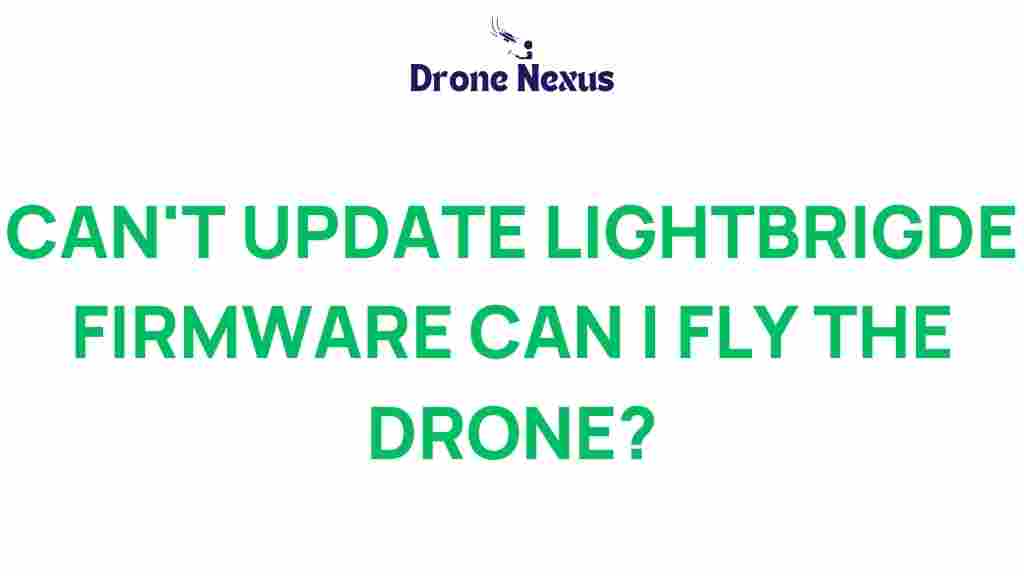What to Do When You Can’t Update Lightbridge Firmware
The Lightbridge firmware is crucial for ensuring your drone operates smoothly and efficiently. However, there may come a time when you find yourself unable to update this firmware. Whether it’s due to a technical glitch, compatibility issues, or simply a lack of resources, it’s essential to understand the implications of not updating your Lightbridge firmware and the options you have for flying your drone safely.
Understanding Lightbridge Firmware
Lightbridge, developed by DJI, is a powerful tool that enables real-time HD video transmission and control of your drone. Regular updates to the Lightbridge firmware not only enhance performance but also fix bugs and introduce new features. Missing out on these updates can lead to various issues, including:
- Reduced flight stability
- Incompatibility with newer devices
- Loss of features
- Potential safety risks
Before you decide to fly without the latest Lightbridge firmware, it’s essential to assess the situation carefully.
Can You Still Fly Without Updating Lightbridge Firmware?
Yes, you can still fly your drone without updating the Lightbridge firmware, but there are several factors to consider. Here’s a breakdown:
- Current Firmware Version: If your current firmware is stable and has no known issues, it may be safe to fly.
- Flight Environment: If you’re flying in an area with minimal interference and good GPS signal, you might encounter fewer issues.
- Experience Level: Experienced pilots may handle the risks better than beginners.
- Drone Model: Some models are more forgiving than others when it comes to outdated firmware.
However, it’s important to note that flying with outdated firmware can pose risks to both your drone and those around you.
Step-by-Step Process for Troubleshooting Lightbridge Firmware Update Issues
When you cannot update the Lightbridge firmware, follow these steps to troubleshoot the problem:
Step 1: Check Your Device Compatibility
Ensure that your mobile device or computer is compatible with the version of the Lightbridge firmware you are trying to update. Incompatible devices can lead to update failures.
Step 2: Ensure a Stable Internet Connection
A stable internet connection is essential for downloading the necessary files. Check your Wi-Fi or mobile data connection before attempting the update again.
Step 3: Restart Your Devices
Sometimes, a simple restart can solve various issues. Power off your drone, remote controller, and mobile device, then turn them back on.
Step 4: Reinstall the DJI Go App
If you’re using the DJI Go app, try uninstalling and reinstalling it to ensure you have the latest version. This can fix bugs that may interfere with the update process.
Step 5: Use a Different Device
If you continue to experience issues, try using a different mobile device or computer to perform the update. Sometimes, the issue lies with the original device.
Step 6: Check for Hardware Issues
Inspect your drone and remote controller for any physical damage that may affect connectivity. If you notice any issues, consider seeking professional help.
Step 7: Consult DJI Support
If all else fails, reaching out to DJI Support can provide you with expert advice and solutions specific to your situation.
Best Practices for Flying with Outdated Lightbridge Firmware
If you decide to fly your drone without updating the Lightbridge firmware, consider following these best practices to ensure a safer flight:
- Pre-Flight Checks: Conduct thorough pre-flight checks to ensure all systems are functioning correctly.
- Fly in Open Spaces: Avoid flying in congested areas where potential interference could be problematic.
- Monitor Battery Levels: Always keep an eye on battery levels and return to home early if necessary.
- Limit Flight Time: If you’re unsure about the firmware, limit your flight time to minimize risks.
- Stay Informed: Keep an eye on online forums and communities for any known issues with your current firmware version.
Common Issues with Outdated Lightbridge Firmware
Flying with outdated Lightbridge firmware can lead to various issues, some of which include:
- Reduced Video Quality: An outdated firmware may not support new video formats or resolutions.
- Connectivity Problems: You may experience lag or dropped connections during flight.
- Inaccurate GPS: Older firmware can lead to GPS inaccuracies, putting your drone at risk.
- Limited Features: New features available in updates may not be accessible, limiting your flying experience.
Conclusion
While it is possible to fly your drone without updating the Lightbridge firmware, it’s crucial to understand the associated risks and limitations. Following the troubleshooting steps outlined above can help you address update issues effectively. If all else fails, consider flying your drone in a controlled environment until you can resolve the update problem.
Remember, keeping your Lightbridge firmware updated is essential for the overall performance and safety of your drone. The best course of action is always to resolve any update issues and ensure your firmware is current before taking to the skies.
For more information on drone safety and maintenance, check out our comprehensive guide on drone care.
This article is in the category Technology and created by DroneNexus Team
